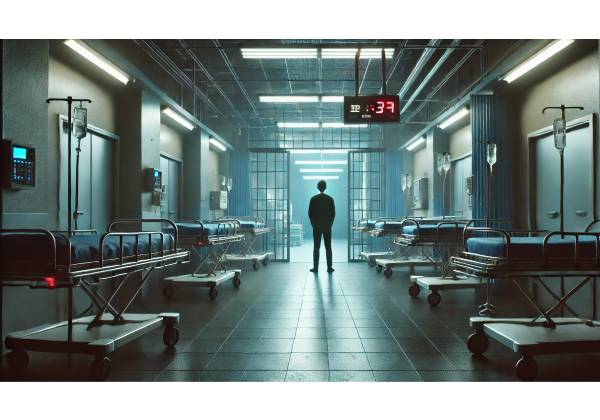
What is Nosocomephobia?
Nosocomephobia is a phobia defined by an intense, irrational fear of hospitals. Individuals with nosocomephobia experience intense anxiety at the prospect of entering a hospital, receiving medical treatment, or even hearing about hospitals. While some discomfort with hospitals is normal—often due to associations with illness or injury—those suffering from nosocomephobia experience crippling fear that can disrupt their lives, causing them to avoid necessary medical care, such as routine check-ups, emergency visits, and procedures.
For those suffering from nosocomephobia, the hospital setting may represent danger, illness, or death, exacerbating their anxiety. This fear frequently spreads to other related triggers, such as medical equipment, healthcare professionals, or even visiting loved ones in the hospital. In more severe cases, even the mention of a hospital can cause a full-fledged panic attack.
Understanding nosocomephobia is critical because avoiding hospitals can be harmful to one’s health. Fear of medical settings can result in delayed treatment, worsening conditions, or a refusal to undergo necessary procedures. Individuals can learn about the causes, symptoms, and treatments for nosocomephobia, allowing them to better manage their fear and quality of life.
Common Symptoms of Nosocomiphobia
Nosocomephobia causes a variety of symptoms that can affect one’s physical, emotional, and behavioral well-being. These symptoms frequently appear when the individual is exposed to hospitals or medical environments, but they can also occur in anticipation of visiting or even thinking about hospitals. The following are the primary symptoms of nosocomephobia.
Physical Symptoms
The physical symptoms of nosocomephobia are closely related to the body’s natural “fight or flight” response, which is triggered by a perceived threat. Individuals with this phobia, the mere thought of a hospital can cause a range of physical reactions, including:
- Rapid heart rate (tachycardia): Fear and anxiety about hospitals can cause the heart to race, often accompanied by palpitations or a sense of panic.
- Shortness of breath or hyperventilation: As anxiety levels rise, people may have difficulty breathing, resulting in shallow, rapid breaths or hyperventilation.
- Sweating and trembling: Hospital-related stimuli can cause excessive sweating, especially on the palms, face, or torso, as well as shaking or trembling.
- Nausea or upset stomach: Anxiety can affect the digestive system, causing nausea, stomach pain, or even vomiting at the prospect of visiting a hospital.
- Dizziness or fainting: The intensity of the fear can make people feel lightheaded or dizzy, especially if they are in or near a hospital.
- Chest pain or tightness: Many people with nosocomephobia experience chest tightness or pain, which can exacerbate their fear and heighten the perception of a medical emergency.
Emotional and cognitive symptoms
Nosocomephobia has a significant impact on emotional and cognitive functioning, often resulting in persistent anxiety, irrational fears, and intrusive thoughts. Some of the emotional and cognitive symptoms are:
- Panic attacks: The prospect of visiting a hospital can cause full-fledged panic attacks, which are marked by intense fear, difficulty breathing, and a sense of impending doom. These attacks can happen even when the person is far from a hospital.
- Excessive worry or dread: People with nosocomephobia frequently experience chronic anxiety about having to visit a hospital, even if there is no medical reason. This persistent dread can impair their ability to concentrate on everyday tasks.
- Intrusive thoughts about illness or death: Hospitals are frequently associated with illness, injury, or death, and people suffering from nosocomephobia may have recurring thoughts or mental images of these outcomes, even if they are otherwise healthy.
- Fear of losing control: Many people with nosocomephobia are afraid of losing control of their emotions or their surroundings while in a hospital, which exacerbates their anxiety. This can include anxiety about fainting, having a panic attack, or being unable to leave the hospital.
- Irrational beliefs about hospitals: People suffering from nosocomephobia may develop irrational fears or beliefs, such as believing that entering a hospital will make them sick or that hospitals are inherently dangerous places where bad things happen.
Behavioral Symptoms
Individuals with nosocomephobia may exhibit significant behavioral changes as they try to avoid situations that may cause them anxiety. Some common behavioral symptoms are:
- Avoidance of hospitals or medical settings: One of the most noticeable symptoms of nosocomephobia is avoiding hospitals, even when medical care is urgently required. This avoidance can include routine checkups, emergency visits, and elective procedures.
- Refusing to visit sick loved ones: People who are afraid of hospitals may avoid visiting family members or friends who are in the hospital, which can lead to feelings of guilt or strained relationships.
- Delaying or refusing medical treatment: Many people with nosocomephobia put off receiving necessary medical care, which can lead to worsening health conditions or complications. In some cases, they may refuse treatment completely.
- Procrastinating on medical appointments: Even if people recognize the need for medical care, they may delay scheduling or attending appointments because they are afraid of hospitals.
- Compensatory behaviors: Some people may engage in compulsive behaviors to cope with their fear, such as excessive research into medical conditions, avoiding conversations about hospitals, or seeking constant reassurance from others.
Impact on Daily Life
For people with nosocomephobia, the fear of hospitals can interfere with their personal health, relationships, and careers. Fear-based avoidance can result in missed opportunities for preventive care, such as vaccinations or screenings, increasing the likelihood of developing more serious health problems. Socially, the phobia may cause people to isolate themselves from loved ones who require medical care or support, whereas professionally, it can result in missed workdays or a refusal to perform healthcare-related job duties.
What Are the Causes of Nosocomephobia?Exploring the Origins and Risk Factors
Nosocomephobia, like many other specific phobias, is often caused by a combination of genetic, environmental, and psychological factors. Understanding the causes of this phobia can provide valuable insight into why some people develop a strong fear of hospitals and how to address it. We will look at the primary causes and risk factors for nosocomephobia.
Traumatic Experiences
A traumatic experience in a hospital or medical setting is a common cause of nosocomephobia. This may include:
- Observing a distressing event in a hospital: If a person has witnessed a loved one’s medical emergency or death in a hospital setting, they may associate hospitals with pain, suffering, or loss.
- Personal negative experiences: Those who have undergone difficult or painful medical treatments—such as surgery, extended hospital stays, or adverse drug reactions—may develop a long-term fear of hospitals as a result of their experiences.
- Early childhood hospitalizations: Children who spend time in hospitals due to illness or injury may develop a lifelong fear of medical environments, especially if their experiences were painful, isolated, or frightening.
Learned Behavior and Conditioning
Nosocomephobia can also result from learned behavior or conditioning, particularly during childhood. If a child sees a parent or caregiver express fear or anxiety about hospitals, they may internalize these feelings and develop similar fears. Furthermore, media depictions of hospitals as dangerous or frightening places, such as in horror films or medical dramas, can strengthen the link between hospitals and fear.
Pre-existing Anxiety Disorders
People with pre-existing anxiety disorders, such as generalized anxiety disorder (GAD), panic disorder, or health anxiety, are more likely to develop nosocomephobia. Their increased sensitivity to potential threats or perceived dangers makes hospitals, which are associated with illness and injury, a common source of fear.
Fear of medical conditions or death
Nosocomephobia is frequently associated with a generalized fear of illness, injury, or death. For some people, the hospital is a place where they must face their own mortality or vulnerability. This fear can be especially strong in people who have hypochondria or a high fear of contracting diseases.
Cultural and Social Influences
Cultural attitudes towards hospitals and healthcare can also influence the development of nosocomephobia. In some cultures, hospitals are primarily viewed as places where people go to die or where dangerous diseases spread, which can heighten fear. Furthermore, societal pressures to maintain good health may cause people to fear the consequences of receiving medical care, viewing it as a sign of weakness or failure.
Genetic Predisposition
There is evidence that phobias, including nosocomephobia, may have a genetic basis. Individuals with a family history of anxiety disorders or specific phobias may be more likely to develop similar conditions, as they may inherit a proclivity for increased fear responses. However, genetics alone are insufficient to cause the phobia; environmental and psychological factors are also important.
How Nosocomephobia is Diagnosed
Nosocomephobia is diagnosed after a thorough assessment by a licensed mental health professional, such as a psychologist or psychiatrist. This process entails evaluating the individual’s symptoms, investigating their fear of hospitals, and ruling out other potential sources of anxiety. Here’s an overview of the diagnostic process.
Clinical Interview
The first step in diagnosing nosocomephobia is a thorough clinical interview. During this session, the mental health professional will inquire about the individual’s fear of hospitals, including when the fear first developed, what specific triggers cause anxiety, and how the fear affects their daily life. The clinician may also inquire about the individual’s personal history, including any previous traumatic experiences with hospitals or medical treatments, family history of anxiety or phobias, and how the fear has evolved over time. This thorough interview helps determine whether the individual’s fear meets the criteria for nosocomephobia or is part of a larger anxiety disorder.
Diagnostic Criteria
Nosocomephobia is diagnosed using the DSM-5’s criteria for specific phobias. The following criteria must be met for a diagnosis:
- Excessive fear or anxiety about hospitals that outweighs the actual risk of visiting a hospital or receiving medical treatment.
- The fear causes significant distress or impairment in daily functioning, including social, professional, and personal health management.
- The individual has persistent avoidance of hospitals, which frequently results in missed appointments, delays in treatment, or avoidance of hospitals even in emergencies.
- The fear and avoidance behavior are ongoing, usually lasting six months or more.
- The fear response is not better explained by another mental health condition, such as generalized anxiety disorder (GAD), post-traumatic stress disorder (PTSD), or obsessive-compulsive disorder (OCD).
Psychological Assessments
In addition to the clinical interview, the mental health professional may conduct standardized psychological assessments to determine the severity of the phobia. These tools assist in quantifying the individual’s level of anxiety, avoidance behaviors, and the overall impact of the phobia on their life. Some commonly used assessments include the Fear Survey Schedule and the Specific Phobia Scale. These assessments can provide a more complete picture of the individual’s experience and aid in the development of an effective treatment plan.
Rules Out Other Conditions
It is critical to distinguish nosocomephobia from other anxiety-related conditions, as fear of hospitals can be a symptom of a larger anxiety disorder. Individuals with health anxiety (hypochondria) may fear hospitals because they are afraid of contracting diseases, but their primary concern is with their health rather than the hospitals themselves. Similarly, individuals with post-traumatic stress disorder (PTSD) may avoid hospitals due to the trauma associated with medical experiences. Accurate diagnosis ensures that the patient receives the best treatment for their specific condition.
Treating Nosocomephobia: Therapies and Interventions
Nosocomephobia is treated using a combination of therapeutic techniques and, in some cases, medication to help people overcome their fear of hospitals. The goal of treatment is to reduce the individual’s anxiety and avoidance behaviors while also making them feel more at ease and confident in medical settings. The most effective treatments for nosocomephobia are listed below.
Cognitive-Behavioral Therapy (CBT)
Cognitive Behavioral Therapy (CBT) is one of the most popular and effective treatments for nosocomephobia. CBT enables people to identify and challenge the irrational thoughts and beliefs that contribute to their fear of hospitals. Working with a therapist teaches people how to reframe their thinking and develop healthier responses to hospital-related anxiety.
cognitive restructuring is a key component of CBT, which assists people in recognizing distorted thoughts and replacing them with more balanced, realistic ones. For example, a person suffering from nosocomephobia may believe that visiting a hospital will inevitably result in something bad happening, such as contracting a disease or receiving a frightening diagnosis. The therapist uses cognitive restructuring to challenge the individual’s beliefs, providing evidence-based perspectives that reduce fear.
Exposure Therapy
Exposure therapy, a type of behavioral therapy that is frequently combined with CBT, is extremely effective for treating nosocomephobia. The idea behind exposure therapy is that by gradually exposing the individual to the feared situation—in this case, hospitals—they will eventually become desensitized to the fear. This process reduces anxiety and teaches the person that hospitals are not inherently dangerous.
The exposure process typically begins with less anxiety-inducing tasks, such as viewing images of hospitals or discussing medical settings in a therapy session. The therapist will gradually introduce more direct exposures, such as visiting a hospital parking lot, walking down a hospital corridor, or eventually accompanying a loved one to a medical appointment. The pace of exposure is determined by the individual’s comfort level, allowing them to confront their fears in a safe and supportive environment.
Virtual reality exposure therapy (VRET)
For those who are not yet ready to confront hospitals in person, Virtual Reality Exposure Therapy (VRET) provides a cutting-edge alternative. VRET simulates hospital environments using virtual reality technology, allowing people to confront their fears in a safe and controlled virtual space. VRET has been shown to be effective in treating a variety of specific phobias, including nosocomephobia, by providing realistic exposure without the need for the patient to visit a hospital.
During VRET sessions, the individual may virtually “walk” through hospital hallways, sit in waiting rooms, or interact with medical staff, all while receiving therapy. Over time, repeated exposure to this virtual environment can help reduce anxiety and boost confidence, making it easier to visit hospitals in person.
Mindfulness and Relaxation Techniques
Mindfulness-based therapies can be extremely effective in reducing the anxiety associated with nosocomephobia. Meditation, deep breathing exercises, and progressive muscle relaxation are all mindfulness practices that help people stay grounded in the present moment and reduce their tendency to overreact to hospital visits.
Individuals with nosocomephobia can better manage their fear responses in or near a hospital setting by learning to focus on their breathing or bodily sensations during times of anxiety. These relaxation techniques are especially effective for reducing anticipatory anxiety, which occurs when people are overly concerned about an upcoming hospital visit.
Acceptance & Commitment Therapy (ACT)
Acceptance and Commitment Therapy (ACT) is another therapeutic approach that can help people with nosocomiphobia. ACT encourages people to accept their fear of hospitals rather than attempting to eliminate it completely. The goal of ACT is to live a meaningful life in the face of fear, using mindfulness strategies to stay present and committed to actions that are consistent with one’s values.
For example, someone with nosocomephobia may avoid visiting a loved one in the hospital out of fear. ACT teaches the individual that, while their fear is valid, their desire to support their loved one may be more important. Individuals who learn to tolerate the discomfort associated with hospitals can take actions that are consistent with their personal values and goals.
Hypnotherapy
Hypnotherapy can be an effective addition to other treatment options for nosocomephobia. During hypnotherapy sessions, the individual is guided into a deep state of relaxation, making them more open to suggestion. In this state, the therapist can help the individual reframe their thoughts and beliefs about hospitals by offering positive suggestions that reduce fear and anxiety.
While hypnotherapy is not typically used as a stand-alone treatment for nosocomephobia, it can be a useful adjunct, especially for people who struggle with deep-seated fear or resistance to change.
Medication
In some cases, medication may be prescribed to help manage the symptoms of nosocomephobia, especially if the phobia is severe or coexists with other anxiety disorders. Selective serotonin reuptake inhibitors (SSRIs), such as fluoxetine or sertraline, are commonly used to improve mood and reduce anxiety by increasing serotonin levels in the brain.
Benzodiazepines, such as lorazepam or diazepam, can also be used in the short term to treat acute anxiety symptoms, such as panic attacks that occur prior to or during hospital visits. However, because of the risk of dependency, benzodiazepines are typically used with caution and are prescribed as a supplement to therapy rather than as a long-term solution.
Support Groups and Peer Counseling
Individuals suffering from nosocomephobia may benefit greatly from support groups. In a group setting, people can share their experiences, fears, and successes with others who understand their difficulties. Hearing about other people’s experiences can help to reduce feelings of isolation and provide practical strategies for dealing with hospital anxiety.
Peer counseling, in which people who have successfully overcome nosocomephobia provide advice and support to those who are currently struggling, can also be beneficial. These mentors can offer encouragement, advice, and a sense of hope, allowing individuals to gain confidence in their ability to face their fears.
Lifestyle Changes and Self-Help Strategies
In addition to formal therapy, lifestyle changes and self-help strategies can help people with nosocomephobia better manage their symptoms. Several strategies include:
- Gradual exposure in everyday life: Making small exposures to medical environments, such as going to the pharmacy or driving past a hospital, can help reduce avoidance behaviors over time.
- Journaling: Writing down thoughts and fears about hospitals can help people reflect on their progress, identify triggers, and recognize patterns in their anxiety.
- Practicing relaxation techniques: Including stress-relieving activities like yoga, deep breathing exercises, or progressive muscle relaxation in daily routines can help people manage their overall anxiety levels.
- Developing a support network: Allowing trusted friends or family members to accompany people to medical appointments or hospital visits can provide reassurance and emotional support.
Individuals suffering from nosocomephobia can gradually overcome their fear of hospitals by combining therapy, lifestyle changes, and support.










